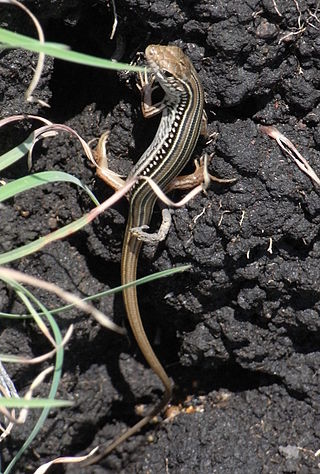
Skinks are lizards belonging to the family Scincidae, a family in the infraorder Scincomorpha. With more than 1,500 described species across 100 different taxonomic genera, the family Scincidae is one of the most diverse families of lizards. Skinks are characterized by their smaller legs in comparison to typical lizards and are found in different habitats except arctic and subarctic regions.

The Solomon Islands skink, also known as prehensile-tailed skink, monkey-tailed skink, giant skink, zebra skink, and monkey skink, is an arboreal species of skink endemic to the Solomon Islands archipelago. It is the largest known extant species of skink.

Ctenotus is a genus of skinks, lizards in the family Scincidae. The genus is endemic to Australia. The genus Ctenotus belongs to a clade in the Sphenomorphus group which contains such genera as Anomalopus and the close relatives Eulamprus and Gnypetoscincus.
Janetaescincus is a genus of burrowing skinks in the family Scincidae. The genus is endemic to the Seychelles. There are two recognized species.

Mochlus is a genus of skinks, lizards in the family Scincidae. The genus is endemic to Africa.
Phoboscincus is a small genus of skinks, lizards in the family Scincidae. There are two known species in the genus Phoboscincus. Both species are found on various island of New Caledonia.
Prasinohaema is a genus of skinks characterized by having green blood. This condition is caused by an excess buildup of the bile pigment biliverdin. Prasinohaema species have plasma biliverdin concentrations approximately 1.5-30 times greater than fish species with green blood plasma and 40 times greater than humans with green jaundice. The benefit provided by the high pigment concentration is unknown, but one possibility is that it protects against malaria.

The genus Sphenomorphus – vernacularly also known as the common skinks – currently serves as a "wastebin taxon" for numerous skinks. While most or all species presently placed here are probably rather close relatives, the genus as presently delimited is likely to be not monophyletic and is in need of review. Some species in this genus have been moved to Pinoyscincus.

Tribolonotus is a genus of lizards, commonly known as crocodile skinks.

Dibamus is a genus of legless lizards in the family Dibamidae.

Vesey-Fitzgerald's burrowing skink is a species of lizard in the family Scincidae. The species is endemic to the Seychelles.

Gardiner's burrowing skink is a species of lizard in the family Scincidae. P. gardineri is the only species in the (monotypic) skink genus Pamelaescincus. The species is endemic to the Seychelles.
George Sprague Myers was an American ichthyologist who spent most of his career at Stanford University. He served as the editor of Stanford Ichthyological Bulletin as well as president of the American Society of Ichthyologists and Herpetologists. Myers was also head of the Division of Fishes at the United States National Museum, and held a position as an ichthyologist for the United States Fish and Wildlife Service. He was also an advisor in fisheries and ichthyology to the Brazilian Government.

The emerald tree skink is sometimes (ambiguously) known as green tree skink or emerald green skink. It is a non-threatened species which is not commonly seen, but it is becoming more popular in the exotic pet trade. In the Philippines, it is called Tabili in the Cebuano language and in Waray.
Sphenomorphus fragosus is a species of lizards from the genus Sphenomorphus'' of the family Scincidae, described by Allen E. Greer and by Parker in the year 1967 in Solomon Islands in Bougainville.
Sphenomorphus darlingtoni is a species of skink, a lizard in the family Scincidae. The species is endemic to Papua New Guinea.
Emoia schmidti, also known commonly as Schmidt's emo skink or Schmidt's skink, is a species of lizard in the family Scincidae. The species is endemic to the Solomon Islands.
Cogger's island skink is a species of lizard in the family Scincidae. The species is endemic to the Admiralty Islands.
The Greer's island skink or Solomon minute skink is a species of lizard in the family Scincidae. It is found in the Solomon Islands.
Sphenomorphus cranei, also known commonly as Crane’s skink and Crane's forest skink, is a species of lizard in the family Scincidae. The species is endemic to the Solomon Islands.









